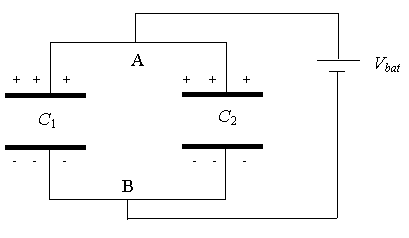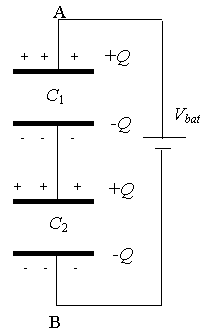Series and parallel capacitors
A capacitor is a device for storing separated charge and
therefore storing electrostatic potential energy. Circuits often contain
more than one capacitor.
 Consider two capacitors in
parallel as shown on the right
Consider two capacitors in
parallel as shown on the right
When the battery is connected, electrons will flow until the potential of
point A is the same as the potential of the positive terminal of the battery and
the potential of point B is equal to that of the negative terminal of the
battery. Thus, the potential difference between the plates of both capacitors is
VA - VB = Vbat. We have C1 = Q1/Vbat
and C2 = Q2/Vbat, where Q1 is the
charge on capacitor C1, and Q2 is the charge on capacitor
C2. Let C be the equivalent capacitance of the two capacitors in
parallel, i.e. C = Q/Vbat, where Q = Q1 + Q2. Then C = (Q1 + Q2)/Vbat = C1 + C2.
For capacitors in parallel, the capacitances add.
For more than two capacitors
we have
C = C1 + C2 + C3 + C4 + ... .
 Consider two capacitors in series as shown on the right.
Consider two capacitors in series as shown on the right.
Let Q represent the total charge on the top plate of C1,
which then induces a charge -Q on its bottom plate. The charge on the
bottom plate of C2 will be -Q, which in turn induces a charge
+Q on its top plate as shown.
Let V1 and V2 represent the potential differences
between plates of capacitors C1 and C2, respectively. Then
V1 + V2 = Vbat, or (Q/C1) + (Q/C2)
= Q/C, or (1/C1) + (1/C2) = 1/C. For more than two
capacitors in series we have
1/C = 1/C1 + 1/C2 +
1/C3 + 1/C4 + ... .
where C is equivalent capacitance of the two capacitors.
For capacitors in series the reciprocal of their
equivalent capacitance equals the sum of the reciprocals of their individual
capacitances.
Problem:
What total capacitances can you make by connecting a 5 μF and an 8 μF
capacitor together?
Solution:
- Reasoning:
We can connect the capacitors either in series or in parallel.
To obtain the largest capacitance, we
have to connect the capacitors in parallel.
To obtain the smallest capacitance, we have to connect the
capacitors in series.
- Details of the calculation:
Connecting the capacitors in parallel:
Clargest = (5 + 8) μF
= 13 μF.
Connecting the capacitors in series.
1/Csmallest = (1/5+ 1/8) (μF)-1 =
13/(40 μF) = 0.325/μF.
Csmallest = 40/13 μF = 3.077 μF.
 Consider two capacitors in
parallel as shown on the right
Consider two capacitors in
parallel as shown on the right Consider two capacitors in series as shown on the right.
Consider two capacitors in series as shown on the right.